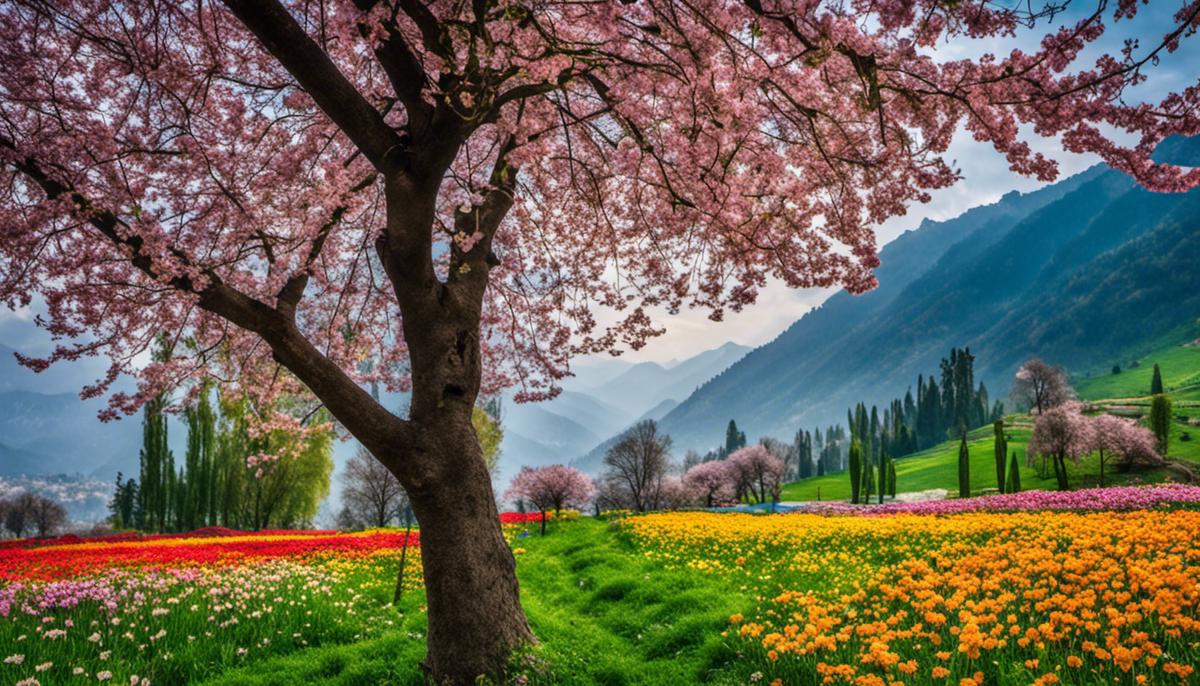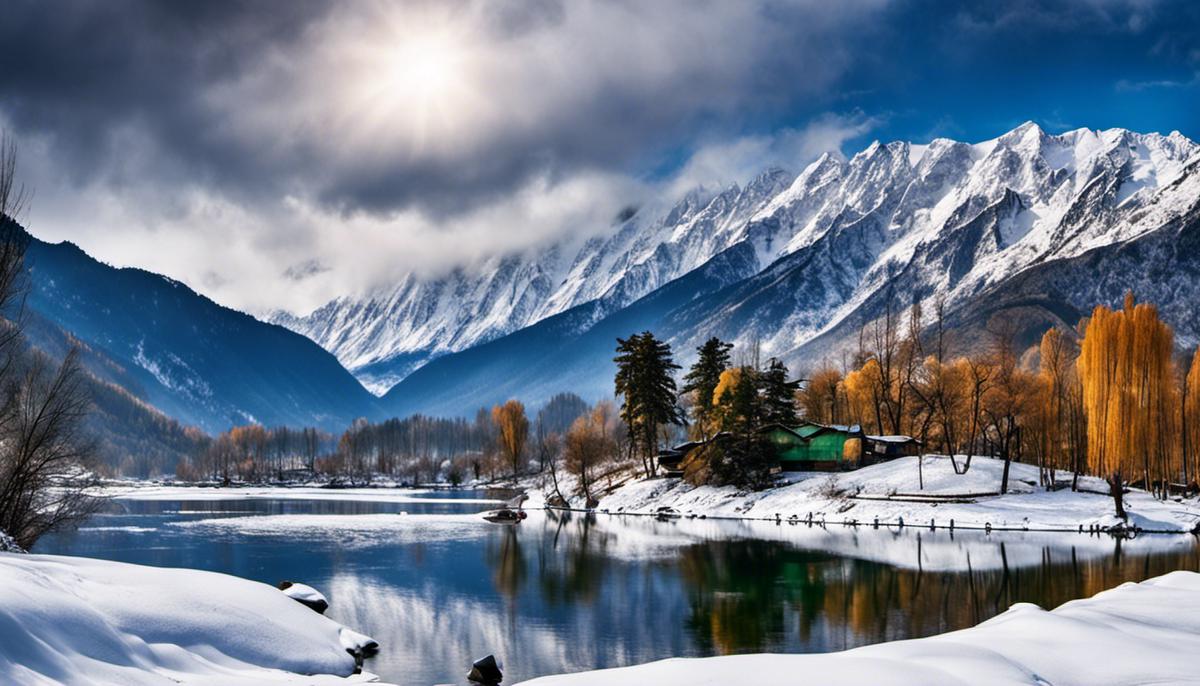|
Getting your Trinity Audio player ready... |
Renowned as the ‘Paradise on Earth’, Kashmir is not just celebrated for its breathtaking beauty but is also recognized for its distinct climate that is largely influenced by its unique geographical presence. Cradled in the lap of the majestic Himalayan ranges, the region endows a fascinating blend of scenery and weather that shapes the lifestyle of its residents while playing a key role in attracting tourists from all around the globe. From the soothing charm of spring and the refreshing allure of monsoon to the frosty winters, the seasonal variations in Kashmir are consequential, offering a new facet of its nature in every change. However, much as nature bestows it with beauty, it too challenges the region with extreme weather conditions, that stretch from heavy snowfall to severe cold, impacting the life and agriculture in the region.
Geographical Position and Its Impact on Weather
Geographical Position: Nestled amidst the Himalayas.
The UT of Jammu and Kashmir, with its unique geographical position, lies in the Northwestern region of the Indian subcontinent. The state shares its borders with Punjab and Himachal Pradesh, and internationally with Pakistan and China. Its distinctive location, nestled amid the Greater Himalayas and the Pir Panjal Range, dramatically influences its weather conditions.
Altitude: A Key Determinant of Weather.
Altitude plays a significant role in dictating the region’s weather pattern. With most regions lying at high altitudes, varying between 850-6200 meters above sea level, Kashmir experiences an array of dramatic meteorological conditions. The higher regions, including Srinagar, Anantnag, and Baramulla, face severe cold weather conditions during winters, while the lower areas, including Jammu, have comparatively warmer weather.
Landscape: A Mixture of Valleys, Mountains, and Lakes.
The specific landscape of the region influences its weather too. The region is a favourable blend of mountains, valleys, lakes, and rivers. This topography leads to distinct microclimates. For instance, the Kashmir Valley, known as the ‘paradise on earth’, surrounded by towering snow-capped peaks, experiences severe winters with heavy snowfall. On the other hand, the relatively flat areas around the Jhelum River, have mild winters and tolerable summers, making it ideal for agriculture.
Proximity to Water Sources: Impact on Humidity and Temperature.
Host to numerous water sources, including rivers, lakes, and glaciers, the region witnesses a direct impact on its weather. The abundant water bodies contribute to a high level of humidity in the region. It also experiences a moderate climate due to the balancing effect of these water sources on temperature. For instance, Dal Lake in Srinagar has a moderating impact, preventing extreme temperatures. Similarly, the glaciers in the higher mountainous regions significantly contribute to the cold weather.
Impact of Himalayan Ranges on Weather.
The mighty Himalayan ranges, including the Greater Himalayas and Pir Panjal, not just influence Kashmir’s topography but significantly impact its weather. They act as a barrier for the cold Central Asian winds, retaining the moisture-laden winds from the Arabian sea, leading to precipitation in the region. This barrier effect of the Himalayas results in moderate summers and harsh winters in Kashmir.
The weather patterns of Kashmir are heavily influenced by its unique geographical positioning, a diverse range of altitudes, an array of landscapes, and an abundance of water sources. Its climate oscillates from icy winters, ushered in by high, snow-covered peaks, to mild climates generated by vast water bodies. Such diversity gives Kashmir a rich platter of varying weather conditions.

Seasonal Variations in Kashmir
Kashmir in Spring: A Season of Rejuvenation
Springtime in Kashmir, spanning from March to the end of May, is symbolic of rejuvenation and growth. Fruit trees such as almonds, cherries, apples, peaches, and pears burst into a riot of colors against the valley backdrop. This shift in season also brings about a change in temperature, transitioning from a brisk cold to a comfortable warmth, typically between 14°C and 21°C (57°F and 70°F). It is common for light spring showers to grace this season, delivering the crucial hydration needed for the fresh buds and leaves to flourish.
Summer in Kashmir: Sunny Retreats
The summer season in Kashmir starts in June and lasts till August. During these months, the weather conditions are typically warm and not extreme, maintaining Kashmir’s reputation as a summer retreat. The day time temperature during the summer rarely exceeds 30°C (86°F) and drops to around 20°C (68°F) during the night. The summer season is arguably the busiest time in the valley, attracting tourists worldwide with its lush green meadows and serene lakes.
Monsoon in Kashmir: Cloudy Skies and Rainfall
The monsoon in Kashmir begins in July and lasts till September. Unlike typical monsoons in other parts of India, Kashmir experiences only modest rainfall. During this season, the temperature ranges between 25°C and 35°C (77°F and 95°F). The frequent rain showers in this season bring a certain chill in the air and are often followed by sunny intervals, making it quite unpredictable yet charming.
Autumn in Kashmir: Falling Leaves and Crisp Air
Autumn arrives in Kashmir in October and lasts till the end of November. The colors of the leaves shift from green to golden and then to russet and red. The temperature starts to drop, ranging from 10°C to 27°C (50°F to 81°F). The weather remains quite dry, with a new chill in the air indicating the arrival of the cold winter months.
Experiencing Winter in Kashmir: The Enthralling Beauty amid Icy Winds and Snow-Covered Peaks
Winter season in Kashmir, commencing in December and enduring till February, is notably severe. During this time, the region frequently experiences snowfall, often covering its landscape in a thick blanket of snow. Temperatures can plunge below freezing point to even -2°C (28°F) and seldom rise above 10°C (50°F). Yet, the frigid conditions bring with them a unique enchantment as they transform Kashmir into a picturesque winter wonderland. This mesmerizing transformation woos tourists who visit to revel in winter recreation such as skiing and snowboarding.

Extreme Weather Conditions and Patterns
The Unpredictable and Severe Weather Conditions in Kashmir
Despite its breathtaking natural beauty, Kashmir is often at the mercy of extreme weather conditions. Ranging from intense cold, to substantial snowfall, to even catastrophic floods, these hazardous instances are known for their unpredictability and recurrence.
The region faces a bitter cold wave typically from November to February, and sometimes even beyond. Specifically, temperatures in the valley often drop to negatives, with places like Drass sometimes witnessing lows of -15 degrees Celsius. This place is known for being the coldest populated area in India. Local residents face tough times during these months as they struggle to stock essential supplies to survive the harsh winter. Moreover, the critical low temperatures pose significant health challenges, especially for the elderly and those with existing respiratory conditions.
Heavy Snowfall In Kashmir: Beautiful Yet Dangerous
Typically, the region receives its first snowfall of the season around late November or early December. Snowfall intensifies as winter progresses, often leading to the blockage of roads and passes, such as the strategic Srinagar-Jammu National Highway, which serves as the primary road connectivity to the rest of the country. Beyond its noticeable impact on life and infrastructure in the region, snowfall has a crucial role in sustaining water supply for the year, as they feed the rivers and lakes during the melting period in spring.
However, heavy snowfall can indeed turn disastrous. Avalanches are common in the region, often claiming lives and damaging properties. When extreme snowfall happens, areas across Kashmir, including its capital city, Srinagar, get effectively isolated due to blockage of road and air transport.
Floods in Kashmir: A Recurring Calamity
Floods form another extreme weather pattern that Kashmir regularly grapples with, causing immense loss of life and property. They typically occur due to heavy rainfall during spring and summer and due to the melting of the heavy snow accumulated in winter.
Floods wreak havoc causing landslides, damaging homes, and washing away vast swathes of agricultural land, therefore, striking a debilitating blow to the region’s economy. The Jhelum River, which flows through the region, often overflows its banks during the rainy season, leading to widespread flooding.
Weather extremes are a common occurrence in the Kashmir region, keeping the people constantly ready to confront and manage the unexpected. The trend of extreme weather extends beyond the Kashmir valley to the regions of Ladakh and Jammu, displaying a similar level of severity and the potential for destruction. To help the inhabitants and local authorities better prepare for these severe weather challenges, understanding these patterns is crucial. This knowledge can be used to strengthen infrastructure and initiate timely evacuations when necessary.

Impact of Weather on Lifestyle and Tourism
The Role of Weather in Shaping Daily Life and Agricultural Practices in Kashmir
The weather in Kashmir plays a pivotal role in molding the everyday activities and agricultural customs of the people who live there. The region experiences a temperate climate and as seasons change, so does the weather.
In the winter months of November through March, Kashmir is hit with heavy snowfall and incredibly low temperatures. This significantly limits outdoor operations, including farming and transportation. In particular, rural inhabitants use wood-burning stoves and heaters to keep themselves warm and utilize their time indoors to engage in activities such as spinning wool and embroidery.
When it comes to farming, the weather has a substantial impact. Renowned for its horticulture, the region produces crops like apples, cherries, peaches, apricots, strawberries, and walnuts, which flourish in the temperate climate. But the severity of winter restricts what and how much can be grown during this time.
As spring and summer set in, from April to October, life in Kashmir undergoes a significant transformation. The weather turns warmer, making outdoor activities viable again. Farming takes center stage during this time, with the meltwater from the snow aiding in irrigation. This is the optimal time for growing crops such as paddy, maize, and various kinds of vegetables.
Impact of Weather on Tourism in Kashmir
Kashmir’s weather conditions also significantly influence the region’s tourism industry. The winter season attracts tourists from across the globe who come to enjoy the snowfall and participate in winter sports such as skiing and snowboarding. Gulmarg, often referred to as the heart of winter sports in India, draws many tourists owing to its powdery snow and well-equipped skiing base.
On the other hand, in the summer months, when the weather is salubrious, tourists visit the region to escape from the scorching heat in other parts of India. Popular activities during summer include boat riding in Dal Lake, trekking, mountain climbing, and sightseeing. The Mughal Gardens, a UNESCO World Heritage Site, come to life during this time with blooming flowers.
However, unpredictable weather changes and calamities, such as heavy snowfall or flash floods, can disrupt the tourist inflow. The tourism infrastructure, including transportation and accommodation, could also be affected due to such severe weather conditions.
The weather plays a pivotal role in shaping the lifestyle, farming methods, and tourism sector in Kashmir. Living in this region creatively involves adjusting to the varying weather conditions and shifts in seasons.

Climate Change and Its Impact on Kashmir’s Weather
Climate Change’s Impact on Kashmir
The varied climate of Kashmir, a hallmark of its regional identity, has been subjected to significant changes due to global climate change. The area now experiences harsher winters, delayed monsoons, decreased snowfall, and unpredictable rainfall. These drastic shifts are turning into major issues for not just humans, but also the region’s wildlife.
The decrease in snowfall and rising temperatures are seen as strong indicators of global warming. Winters in recent years have been much colder, often dipping below the freezing point. This deviation from the traditional weather patterns of the region disrupts the habitual cycles of both the local people and the wildlife.
Erratic Rainfall Patterns
One of the apparent effects of climate change in Kashmir is the unpredictable rainfall pattern. This region is witnessing an increased frequency of extreme rain events that lead to devastating floods, landslides, and soil erosion, ultimately affecting local agriculture and economies. This inconsistency in rainfall is attributed to the warming of the Indian Ocean, which has shown a considerable temperature increase in the past few decades.
Melting Glaciers and Its Consequences
The rising temperatures in Kashmir have resulted in the melting of glaciers at an alarming rate. These glaciers are essential as they feed the rivers and streams that the population heavily depends on for irrigation, power generation, and drinking water. Rapid glacial melt could lead to the extinction of these rivers and streams, leading to a severe water crisis in the future.
Similarly, the disappearance of glaciers could also lead to a threat known as Glacial Lake Outburst Flood (GLOF). It occurs when the dam containing a glacial lake fails, releasing a significant amount of water. The regions downhill become vulnerable to catastrophic flooding, thus posing an enormous threat to life and property in those areas.
Effects on Agriculture
Agriculture is a vital sector in the Kashmir economy. However, due to erratic climatic conditions, the region’s agriculture sector is facing severe challenges. Droughts, lack of timely snowfall, and unexpected rainfall have caused crop failures, thus impacting the livelihoods of people dependent on farming.
Conclusion
Weather changes in Kashmir due to global warming and climate change have not only disturbed the ecological balance but are also posing severe threats to human life and the economy. It’s important to acknowledge these changes and work towards creating resilient communities that can adapt to these rising challenges in the future. Simultaneously, efforts to mitigate these effects should also be on the agenda. Implementing sustainable practices, enlightening communities on climate change impacts, and focusing on conservation could be some of the measures towards this goal.

In the present scenario, an ever-looming shadow of concern casts itself over Kashmir – the problem of climate change. The implications of global warming are increasingly becoming unignorable in this region. Unpredictable weather conditions, shifts in seasonal temperature ranges, and an escalated frequency of extreme weather events are all symptoms of the larger global issue showing its impact here. These changes do not stand alone, they interact dynamically with the region, threatening the unique weather pattern, challenging the lifestyle and agriculture, as well as impacting the tourism of this paradise. These changes elicit our immediate attention and action to ensure that the jewel of Kashmir continues to shine unobscured by the hazy veil of climate alteration.


